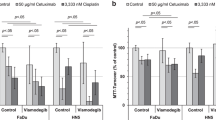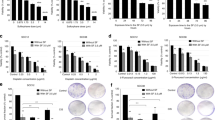Abstract
Purpose
Simvastatin (Sim) is approved as lipid-controlling drug in patients with cardiovascular risk to reduce hypercholesterolemia. Recent publications indicate possible inhibitory effects of Sim on tumor cell lines, and epidemiological data suggest activity in cancer patients. Still, its therapeutic efficacy, particularly in head and neck squamous cell carcinoma (HNSCC), remains to be elucidated. This study analyzes the effects of Sim on HNSCC cell lines (KB, HN5, FaDu) and on a larger set of primary HNSCC cells by employing a short-time ex vivo colony formation test (FLAVINO assay). Possible additive or synergistic effects of Sim combinations with established chemotherapeutics are determined as well.
Methods
Biopsies of 49 HNSCC were tested in the FLAVINO assay with Sim alone or in combination with cisplatin (Cis) or docetaxel (DTX). Cell lines were studied for reference. Epithelial HNSCC cells were stained by Cy2-labeled anti-cytokeratin antibodies facilitating the detection of colony formation (CF) by immunofluorescence. Drug combinations were analyzed regarding their interaction.
Results
Sim alone acted suppressive on tested cell lines and increased the cytostatic efficacy of Cis and DTX. 18/49 HNSCC qualified for FLAVINO-based dose-response analyses, and Sim significantly suppressed CF in 18/18 primary HNSCC. Moreover, Sim increased cytotoxic effects of Cis and DTX, primarily in an additive mode of action.
Conclusions
The ex vivo tumor cell inhibition of Sim and its additive effects upon combination with established cytostatics provide the basis for epidemiological and clinical studies on statins, potentially directed toward co-medication in future treatment regimens.



Similar content being viewed by others
References
Ridker PM, MacFadyen JG, Fonseca FAH, Genest J, Gotto AM, Kastelein JJP et al (2009) Rosuvastatin to prevent vascular events in men and women with elevated c-reactive protein. Circ Cardiovasc Qual Outcomes 2:616–623
Emberson JR, Kearney PM, Blackwell L, Newman C, Reith C, Bhala N et al (2012) Lack of effect of lowering LDL cholesterol on cancer: meta-analysis of individual data from 175,000 people in 27 randomised trials of statin therapy. PLoS One 7:e29849
Jakobisiak M, Golab J (2003) Potential antitumor effects of statins (review). Int J Oncol 23:1055–1069
Fritz G (2009) Targeting the mevalonate pathway for improved anticancer therapy. Curr Cancer Drug Targets 9:626–638
Fritz G (2005) HMG-CoA reductase inhibitors (statins) as anticancer drugs (review). Int J Oncol 27:1401–1409
Zeichner S, Mihos CG, Santana O (2012) The pleiotropic effects and therapeutic potential of the hydroxy-methyl-glutaryl-CoA reductase inhibitors in malignancies: a comprehensive review. J Cancer Res Ther 8:176–183
Kim WS, Kim MM, Choi HJ, Yoon SS, Lee MH, Park K et al (2001) Phase II study of high-dose lovastatin in patients with advanced gastric adenocarcinoma. Invest New Drugs 19:81–83
Larner J, Jane J, Laws E, Packer R, Myers C, Shaffrey M (1998) A phase I–II trial of lovastatin for anaplastic astrocytoma and glioblastoma multiforme. Am J Clin Oncol 21:579–583
Sacks FM, Pfeffer MA, Moye LA, Rouleau JL, Rutherford JD, Cole TG et al (1996) The effect of pravastatin on coronary events after myocardial infarction in patients with average cholesterol levels. Cholesterol and recurrent events trial investigators. N Engl J Med 335:1001–1009
Schachter M (2005) Chemical, pharmacokinetic and pharmacodynamic properties of statins: an update. Fundam Clin Pharmacol 19:117–125
Nielsen SF, Nordestgaard BG, Bojesen SE (2012) Statin use and reduced cancer-related mortality. N Engl J Med 367:1792–1802
Soma MR, Pagliarini P, Butti G, Paoletti R, Paoletti P, Fumagalli R (1992) Simvastatin, an inhibitor of cholesterol biosynthesis, shows a synergistic effect with N,N′-bis(2-chloroethyl)-N-nitrosourea and beta-interferon on human glioma cells. Cancer Res 52:4348–4355
Yanae M, Tsubaki M, Satou T, Itoh T, Imano M, Yamazoe Y et al (2011) Statin-induced apoptosis via the suppression of ERK1/2 and Akt activation by inhibition of the geranylgeranyl-pyrophosphate biosynthesis in glioblastoma. J Exp Clin Cancer Res 30:74
Ogunwobi OO, Beales ILP (2008) Statins inhibit proliferation and induce apoptosis in Barrett’s esophageal adenocarcinoma cells. Am J Gastroenterol 103:825–837
Cho S, Kim JS, Kim JM, Lee JY, Jung HC, Song S (2008) Simvastatin induces apoptosis in human colon cancer cells and in tumor xenografts, and attenuates colitis-associated colon cancer in mice. Int J Cancer 123:951–957
Ghosh-Choudhury N, Mandal CC, Ghosh-Choudhury N, Ghosh Choudhury G (2010) Simvastatin induces derepression of PTEN expression via NFkappaB to inhibit breast cancer cell growth. Cell Signal 22:749–758
Kato S, Smalley S, Sadarangani A, Chen-Lin K, Oliva B, Brañes J et al (2010) Lipophilic but not hydrophilic statins selectively induce cell death in gynaecological cancers expressing high levels of HMGCoA reductase. J Cell Mol Med 14:1180–1193
Takeda I, Maruya S, Shirasaki T, Mizukami H, Takahata T, Myers JN et al (2007) Simvastatin inactivates beta1-integrin and extracellular signal-related kinase signaling and inhibits cell proliferation in head and neck squamous cell carcinoma cells. Cancer Sci 98:890–899
Dietz A, Boehm A, Horn I, Kruber P, Bechmann I, Golusinski W et al (2010) Assay-based response evaluation in head and neck oncology: requirements for better decision making. Eur Arch Otorhinolaryngol 267:483–494
Dietz A (2009) Method and kit for the ex vivo evaluation of the response of a tumor to conditions to be tested. International publication number WO 2009/124997, PCT/EP2009/054297
Schrader C, Boehm A, Reiche A, Dietz A, Mozet C, Wichmann G (2012) Combined effects of lapatinib and cisplatin on colony formation of head and neck squamous cell carcinoma. Anticancer Res 32:3191–3199
Horvat S, McWhir J, Rozman D (2011) Defects in cholesterol synthesis genes in mouse and in humans: lessons for drug development and safer treatments. Drug Metab Rev 43:69–90
Robbins DJ, Hebrok M (2007) Hedgehogs: la dolce vita. Workshop on Hedgehog-Gli signaling in Cancer and Stem Cells. EMBO Rep 8:451–455
Edison RJ, Muenke M (2004) Central nervous system and limb anomalies in case reports of first-trimester statin exposure. N Engl J Med 350:1579–1582
Mozet C, Stoehr M, Dimitrova K, Dietz A, Wichmann G (2013) Hedgehog targeting by cyclopamine suppresses head and neck squamous cell carcinoma and enhances chemotherapeutic effects. Anticancer Res 33:2415–2424
Masters JR (2000) Human cancer cell lines: fact and fantasy. Nat Rev Mol Cell Biol 1:233–236
Sobin LH, Gospodarowicz MK, Wittekind C (2010) TNM classification of malignant tumours. International union against cancer, 7th edn. Wiley, Chichester
Desoize B, Berthiot G, Manot L, Coninx P, Dumont P (1996) Evaluation of a prediction model of cisplatin dose based on total platinum plasma concentration. Eur J Cancer 32A:1734–1738
Bissett D, Setanoians A, Cassidy J, Graham MA, Chadwick GA, Wilson P et al (1993) Phase I and pharmacokinetic study of taxotere (RP 56976) administered as a 24-hour infusion. Cancer Res 53:523–527
Jin Z (2004) About the evaluation of drug combination. Acta Pharmacol Sin 25:146–147
Graaf MR, Beiderbeck AB, Egberts ACG, Richel DJ, Guchelaar H (2004) The risk of cancer in users of statins. J Clin Oncol 22:2388–2394
Ahern TP, Pedersen L, Tarp M, Cronin-Fenton DP, Garne JP, Silliman RA et al (2011) Statin prescriptions and breast cancer recurrence risk: a Danish nationwide prospective cohort study. J Natl Cancer Inst 103:1461–1468
Chae YK, Valsecchi ME, Kim J, Bianchi AL, Khemasuwan D, Desai A et al (2011) Reduced risk of breast cancer recurrence in patients using ACE inhibitors, ARBs, and/or statins. Cancer Invest 29:585–593
Farwell WR, D’Avolio LW, Scranton RE, Lawler EV, Gaziano JM (2011) Statins and prostate cancer diagnosis and grade in a veterans population. J Natl Cancer Inst 103:885–892
Singh PP, Singh S (2013) Statins are associated with reduced risk of gastric cancer: a systematic review and meta-analysis. Ann Oncol 24:1721–1730
Knox JJ, Siu LL, Chen E, Dimitroulakos J, Kamel-Reid S, Moore MJ et al (2005) A Phase I trial of prolonged administration of lovastatin in patients with recurrent or metastatic squamous cell carcinoma of the head and neck or of the cervix. Eur J Cancer 41:523–530
Ziviani L, Da Ros L, Squassante L, Milleri S, Cugola M, Iavarone LE (2001) The effects of lacidipine on the steady/state plasma concentrations of simvastatin in healthy subjects. Br J Clin Pharmacol 51:147–152
Goard CA, Mather RG, Vinepal B, Clendening JW, Martirosyan A, Boutros PC et al (2010) Differential interactions between statins and P-glycoprotein: implications for exploiting statins as anticancer agents. Int J Cancer 127:2936–2948
Clendening JW, Penn LZ (2012) Targeting tumor cell metabolism with statins. Oncogene 31:4967–4978
Dimitrova K, Stoehr M, Dehghani F, Dietz A, Wichmann G, Bertolini J et al (2013) Overexpression of the Hedgehog signalling pathway in head and neck squamous cell carcinoma. Onkologie 36:279–286
Incardona JP, Gaffield W, Kapur RP, Roelink H (1998) The teratogenic Veratrum alkaloid cyclopamine inhibits sonic hedgehog signal transduction. Development 125:3553–3562
Schneider S, Thurnher D, Kloimstein P, Leitner V, Petzelbauer P, Pammer J et al (2011) Expression of the sonic hedgehog pathway in squamous cell carcinoma of the skin and the mucosa of the head and neck. Head Neck 33:244–250
Wang Y, Chang C, Lin C, Chang S, Chu P, Tai S et al (2012) Expression of hedgehog signaling molecules as a prognostic indicator of oral squamous cell carcinoma. Head Neck 34:1556–1561
Acknowledgments
The authors would like to thank the colleagues from the Institute of Pathology (C. Wittekind, J. Bertolini and U. Bauer) for providing histopathological data. The laboratory staff (A. Reiche, G. Müller and K. Herrmann) is acknowledged for technical assistance and in particular for material transfer from surgery and for handling of specimens. M. Stoehr and C. Mozet contributed equally to this study under the supervision of G. Wichmann.
Conflict of interest
None.
Author information
Authors and Affiliations
Corresponding author
Additional information
Matthaeus Stoehr and Christian Mozet have contributed equally to this work (shared first authorship).
Rights and permissions
About this article
Cite this article
Stoehr, M., Mozet, C., Boehm, A. et al. Simvastatin suppresses head and neck squamous cell carcinoma ex vivo and enhances the cytostatic effects of chemotherapeutics. Cancer Chemother Pharmacol 73, 827–837 (2014). https://doi.org/10.1007/s00280-014-2412-1
Received:
Accepted:
Published:
Issue Date:
DOI: https://doi.org/10.1007/s00280-014-2412-1




